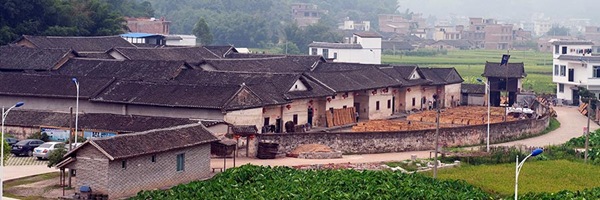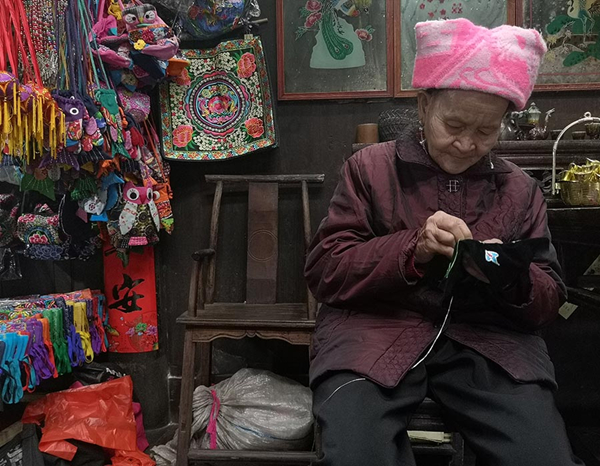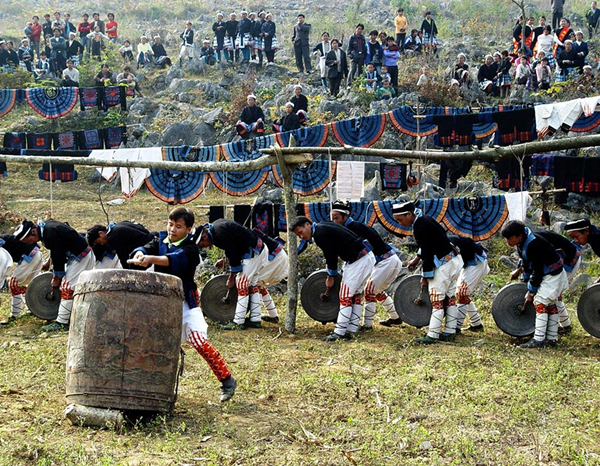Homecoming scenes

Traditional Hakka round houses in the Hakka Ecomuseum in Hezhou in the Guangxi Zhuang autonomous region. [Photo provided to China Daily]
Ecomuseums are transforming the prospects of villages in Guangxi, Xu Lin and Shi Ruipeng report from Longsheng county.
It is a daily routine for 82-year-old Hou Yujin from the Zhuang ethnic group to show tourists around her traditional home, pointing out the exquisite layout and details.
Dating back more than 160 years, the two-story, 180-square-meter residence was built out of fir wood using mortise and tenon work, a process that doesn't require nails.
Traditional Zhuang houses are propped up by wooden supports and have ladders leading up from the first floor-which was generally used for keeping livestock-to the second floor, where the people lived.
"Tourists like to sit around my 200-year-old family table. I'm touched when they offer me their best wishes," says Hou in her home in Longji village in multiethnic Longsheng county in the Guangxi Zhuang autonomous region.
Although Hou lives on her own, her daughters often visit her. She remains in sound health, still does her own housework and enjoys sewing embroidery. She speaks fluent Mandarin and loves to socialize, especially with young people.

Hou Yujin, 82, makes traditional Zhuang embroidery in her ancient house. [Photo by Xu Lin/China Daily]
She recalls how villagers used to plant tea and other crops and raise pigs to make a living, before tourism began bringing in extra income.
Longji village is an ancient Zhuang stockaded settlement with a history dating back over 430 years. It's famous for its picturesque views of terraced fields and well-preserved examples of ancient Zhuang residences.
In 2010, the Longji Zhuang Ecomuseum opened in the village, and Hou's house was chosen as one of the few exemplary residences due to its long history and good state of preservation. The museum helps owners of historical properties to repair their houses and persuades them to preserve antiques and other old items.
It's one of the 10 "ecomuseums" under the guidance of the Anthropology Museum of Guangxi, a traditional museum based in the regional capital, Nanning. Two ecomuseums relate to the history and culture of the Han people, while the remaining eight cover other Chinese ethnic groups.
Guangxi's government started the project in late 2003, and the most recent ecomuseum opened in 2011.
Hou Wenqiang, curator of the ecomuseum in Longji, says: "Many people assume that the village's exhibition hall is the ecomuseum. Actually, the instant you enter the village, you're placing yourself in the ecomuseum, which includes the whole community.
"We need to promote ourselves to raise public awareness about what the definition of an ecomuseum is. China's first ecomuseums were established in the late 1990s in Guizhou province."

Baiku Yao people, a branch of Yao ethnic group who traditionally wear white trousers, beat copper drums in an ecomuseum in Nandan county in Guangxi. [Photo provided to China Daily]
The aim of the project is to protect old residences and preserve historic and cultural relics like tablet inscriptions in the village.
It was a lucky coincidence that tourism companies started to promote the village as a destination to group travelers in 2010, the same year the ecomuseum opened. Owners of old houses like Hou Yujin jumped at the chance to work with travel agencies to receive tourists.
When the village was selected for the ecomuseum project, the local government began building roads to provide better access to the village. Visitors previously had to walk for around an hour along a rocky pass to reach the settlement.
"Our aim was to protect the original ethnic culture here," says Hou Wenqiang. "Villagers soon began to support the ecomuseum because it attracted tourists and helped to preserve their culture."
They also emphasized the need to protect intangible cultural heritage, such as bamboo-woven goods and traditional clothing.
The Zhuang people in Longji village sing folk songs relating to traditional themes, such as farming. Besides using stone to construct bridges and gates, they also use the material to make everyday articles, such as mill stones and water vats. The four major local specialties are tea, rice liquor, glutinous rice and pepper.
Pan Tingfang, former head of the village, says the locals are leading a better life now thanks to the growth in tourism. And this renewed prosperity has attracted more young people to return to their hometown to open restaurants and hotels rather than seek employment as migrant workers in big cities.
According to Pan, the locals are hospitable, honest and kindhearted. They are happy to interact with tourists and tell them about the best places to visit, such as the ecomuseum's exhibition hall.
However, both Pan and curator Hou know how hard it is to maintain the balance between developing tourism and protecting local culture.
"When villagers are building hotels or restaurants with bricks and mortar, there are no specific regulations. It looks a bit strange to have modern buildings among the older architecture," says Hou Wenqiang.
He says the local government should take the initiative to come up with solutions, such as relocating villagers to nearby areas to protect the original character of the villages.
He says that in a nearby village that's proving popular with tourists, much of the architecture has become a pastiche of brick and wood after years of commercialization-and that's the last thing he wants to see happen to Longji village.
